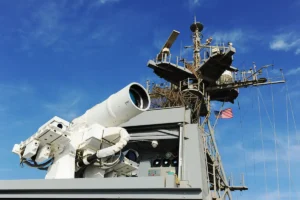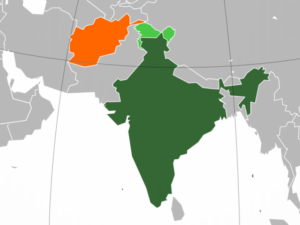By Dr. Minhas Majeed Khan
The fusion of technology and power is reshaping global security in today’s world. Nations leverage advanced technologies like artificial intelligence (AI) and cyber capabilities, altering the geopolitical terrain. This convergence offers new ways to safeguard national interests and brings complex, borderless threats. The ongoing dialogue aims to dissect the role of technological might in national strategy, affecting diplomacy, defense, and global stability. Technology is more than a mere instrument; it’s a force that transforms the security landscape.
Artificial intelligence (AI) refers to computer systems capable of tasks that usually require human intellect, such as learning and problem-solving. Integrating AI into military systems, like drones, boosts efficiency and poses risks, such as the potential for unintended escalations due to reduced human control. Cyber capabilities include the potential and active resources a state can employ in cyberspace to defend or exert influence. These capabilities have revolutionized warfare, exemplified by the Stuxnet worm’s impact on Iran’s nuclear facilities, showcasing the possibility of conflict through digital means rather than traditional combat.
The advent of Lethal Autonomous Weapons Systems (LAWS) and anti-satellite weapons (ASATs) presents ethical concerns and the risk of an arms race, endangering space assets vital for communication and navigation. While these technologies threaten to disrupt traditional industries and deepen economic disparities by replacing jobs, they also offer countries the chance to significantly boost productivity and economic growth. The challenge lies in harnessing these technologies responsibly to ensure broad societal benefits and prevent exacerbating existing inequalities.
The democratization of technology is equipping non-state actors and smaller states with capabilities that were once the sole preserve of major powers. Encryption technology, for instance, has become a double-edged sword. While it protects privacy and secures communication for legitimate purposes, it also offers insurgent groups and terrorist organizations the means to coordinate operations, share information, and evade intelligence agencies’ surveillance with a level of security that was previously unattainable.
The proliferation of cyber capabilities has further leveled the playing field. The dark web, a part of the internet that is not indexed by traditional search engines and requires specific software to access, has become a haven for illicit activities. It provides a marketplace for cyber warfare tools and AI-enabled technologies that can be used for malicious purposes. These tools range from malware and ransomware to sophisticated hacking programs that can disrupt critical infrastructure or steal sensitive data.
Moreover, the accessibility of AI technology has enabled these actors to enhance their operational capabilities. AI can be used to automate tasks, analyze vast amounts of data for intelligence purposes, and even control drones or other autonomous systems in combat scenarios. The challenge for global security is significant; it is not just about countering the threats but also about understanding the implications of these technologies and developing strategies to maintain stability in a rapidly evolving digital battlefield.
These developments call for a reevaluation of deterrence, defense, and arms control strategies. International cooperation and dialogue are crucial in developing norms and agreements to manage these challenges. The United Nations has facilitated discussions on the regulation of LAWS, highlighting the need for a global consensus on the governance of emerging technologies. This restructured narrative emphasizes the dual nature of technological advancements—their potential to contribute to security and their capacity to introduce new risks—underscoring the importance of responsible stewardship in the age of tech-driven power dynamics.
Reflecting on the history of technological advancements, we observe their profound impact on strategic stability and international relations. The Industrial Revolution signified a pivotal shift from manual labor to mechanized production, catalyzing societal transformations and the emergence of new economic frameworks. The Second Industrial Revolution further revolutionized the landscape with mass production, significantly enhancing productivity, spurring economic growth, and altering consumer behavior. Yet, it also led to worker displacement, emphasizing the necessity for social safety nets and strategic investments in infrastructure to adapt to the evolving economy.
The mid-20th century marked another critical technological shift with the development of nuclear weapons. The atomic bombings of Hiroshima and Nagasaki redefined warfare and deterrence, giving rise to the Cold War doctrine of Mutually Assured Destruction (MAD). The advent of intercontinental ballistic missiles (ICBMs) compressed the warning time for an attack, amplifying the significance of second-strike capabilities and fueling an arms race among superpowers.
Technological Evolution and Policy Response: A Strategic Framework
In the face of rapidly advancing technology, the role of policymakers is becoming ever more crucial. They are the sentinels at the frontier of innovation, tasked with the responsibility to foresee potential challenges and opportunities that each new technological wave may bring. Historical shifts in technology serve as powerful lessons, reminding us that adaptability, foresight, and inclusive policies are essential to ensure that the fruits of innovation are distributed fairly among all members of society. These shifts are not just markers of progress; but also, complex puzzles that require a deep understanding to solve. By studying the patterns and outcomes of past technological revolutions, we can better navigate the intricacies of the disruptions we face today.
The strategic framework for addressing these disruptions must be comprehensive, encompassing education to prepare the workforce for future demands, regulation to safeguard public interests, and innovation to drive progress. It should also include international cooperation to tackle the global nature of technological challenges. This framework is not merely a reactive measure, but a proactive blueprint designed to harness the full potential of technological advancements while mitigating their risks.
Efforts to combat cyber threats from terrorist organizations often require international cooperation, capacity building, and innovative technology. For example, the United Nations Office of Counter-Terrorism (UNOCT) has initiated various programs to enhance the cybersecurity capabilities of Member States and private organizations. These programs aim to prevent cyber-attacks by terrorists on critical infrastructure and to minimize the impact of such attacks. In collaboration with INTERPOL, the UNOCT/UNCCT has introduced the CT TECH project, which is funded by the European Union. This project aims to strengthen the capabilities of law enforcement and criminal justice authorities in partner countries to combat the exploitation of new and emerging technologies for terrorist purposes. The Global Counter-Terrorism Programme on Cybersecurity and New Technologies focuses on enhancing skills and capabilities necessary to protect critical infrastructures against terrorist cyber-attacks, as well as to counter and investigate terrorist use of new technologies. Strong partnerships between governments, tech companies, and civil society are essential. These partnerships involve strategic communications with credible voices and positive messages to counter terrorist narratives and propaganda. These efforts showcase the importance of a multi-faceted approach that includes technological innovation, international collaboration, and strategic communication to effectively counter cyber threats posed by terrorist organizations.
Expanding the Framework: Continuous Monitoring and Dynamic Policymaking
To effectively implement this framework, continuous monitoring of technological trends is imperative. Policymakers must stay abreast of the latest developments to anticipate their impact on society. This vigilance allows for the creation of dynamic policies that can adapt to the ever-changing landscape of technology. Such policies must be crafted with the input of a diverse group of stakeholders, including technologists, ethicists, business leaders, and the public, to ensure they are well-rounded and considerate of various perspectives.
Additionally, education plays a pivotal role in this strategic framework. As technology evolves, so too must the skills of the workforce. Policymakers must prioritize education and workforce development to equip individuals with the necessary competencies to succeed in a tech-driven economy. Moreover, ethical considerations must be at the forefront of technological adoption, focusing on privacy, security, and equity to prevent the exacerbation of societal divides.
The framework must also call for global collaboration. In an interconnected world, the challenges and opportunities presented by technology are not confined by borders. International partnerships are essential to address these issues collectively. Additionally, economic and social adaptation strategies, such as investment in research and development, economic diversification, and strengthened social safety nets, are critical to ensure societies can withstand and thrive amidst technological changes.
Conclusion: Navigating Technological Shifts with Strategic Foresight
The lessons of historical technological shifts are clear: They demand a commitment to flexibility, foresight, and the crafting of inclusive policies that ensure the benefits of innovation are shared equitably. In an age where innovation occurs at breakneck speed, all stakeholders must engage in proactive dialogue and take decisive action. Such measures are vital to effectively navigate the complexities of technological disruptions, with the aim of leaving no one behind as we collectively stride towards progress.
This narrative highlights the dual nature of technological advancements. On one hand, they have the potential to significantly enhance security and quality of life. On the other hand, they introduce new risks that must be managed with care. This duality underscores the importance of responsible stewardship in an era increasingly defined by technology’s influence on power dynamics.
In drawing this discussion to a close, it is evident that the historical context of technological shifts does not merely highlight challenges and illuminates the path forward. A strategic approach that embodies flexibility, foresight, and inclusivity is essential. We can steer the course of technological disruptions through proactive dialogue and decisive action, ensuring they serve as a beacon of security and prosperity for all. As we venture into the next era of technological evolution, our collective commitment to responsible stewardship will determine the legacy of our time. It is by acknowledging the dual nature of technology—as both a tool for advancement and a potential source of risk—and addressing it with thoughtful, comprehensive strategies that we can secure a future where technology uplifts humanity as a whole.
References
- Cyber Security and New Technologies. Cybersecurity and New Technologies | Office of Counter-Terrorism
- Understanding the proliferation of Cyber. Understanding the Proliferation of Cyber Capabilities | Council on Foreign Relations (cfr.org)
- Strengthening Multilaterism to Comabt Global Terrorism. ‘Strengthen multilateralism’ to combat global terrorism | UN News
- Cyber Capabilities and National Power: A Net Assessment. Cyber Capabilities and National Power: A Net Assessment (iiss.org)
- Implementing Inclusive Policies Across a Global Organization Implementing Inclusive Policies Across a Global Organization (hbr.org)
- How Technology Can Help Global Trade Become More Inclusive and Equitable. How Technology Can Help Global Trade Become More Efficient, Inclusive And Equitable (forbes.com)








